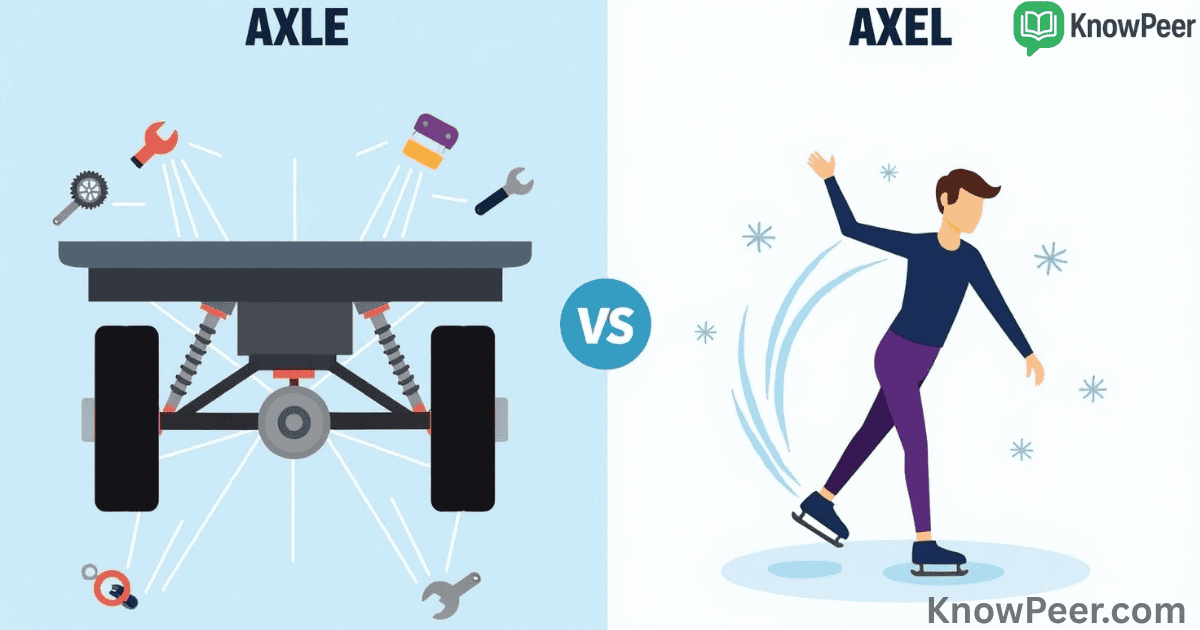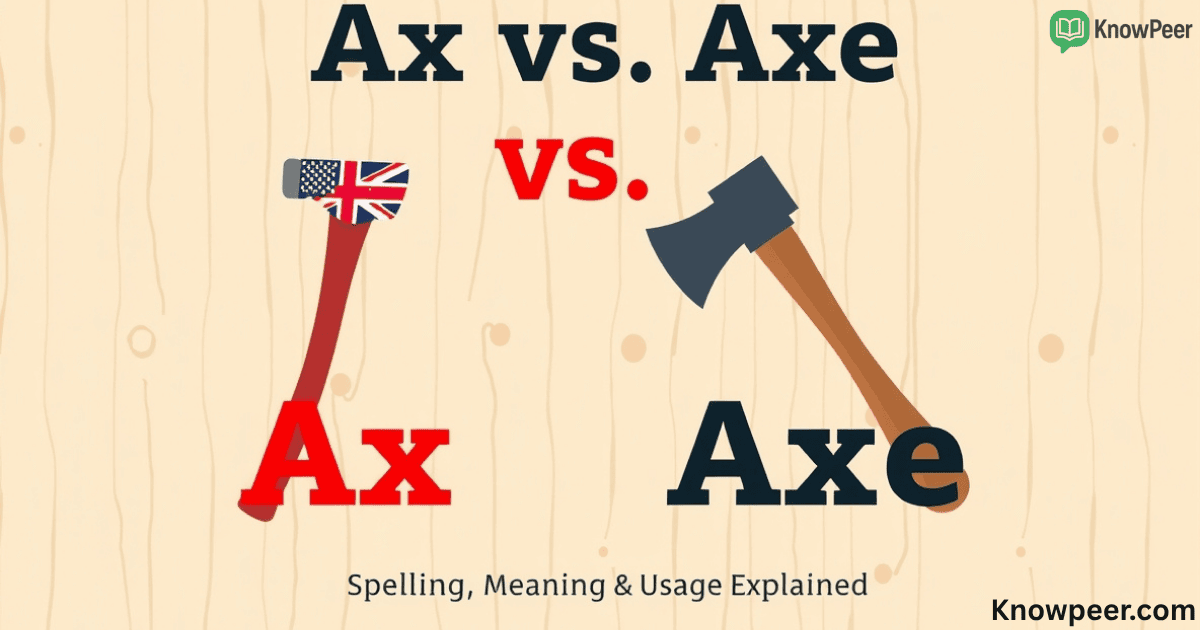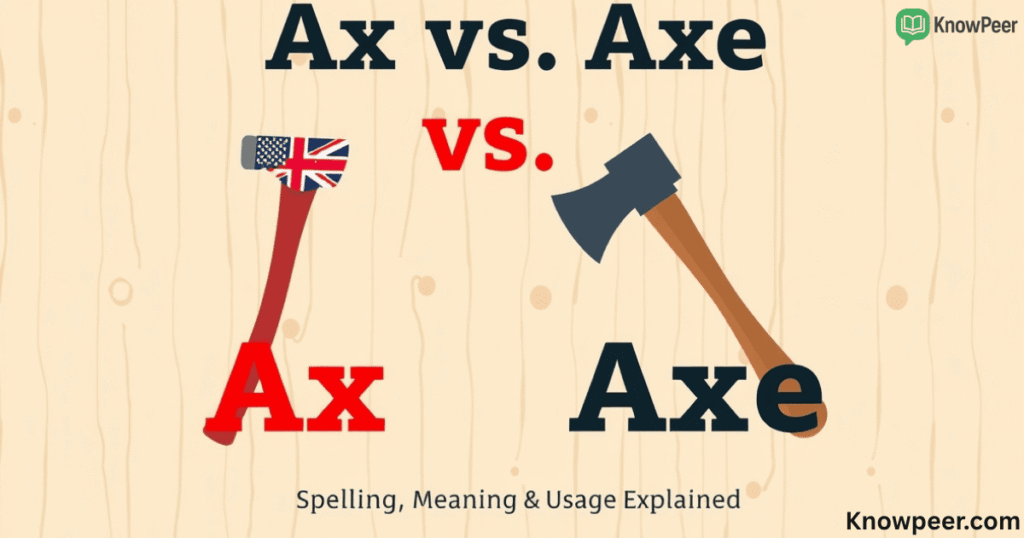Many words in English sound the same but have very different meanings. These are called homophones. One perfect example is “axle” and “axel.” While they only differ by one letter, these two words come from very different worlds—one from mechanical engineering and the other from figure skating. Mistaking one for the other may seem like a small issue, but it can create confusion in writing, speaking, or even professional work.
In this post, we’ll explore everything you need to know about axle vs axel, how they are used, what they really mean, and how to tell them apart. We’ll look at their definitions, origins, common uses, and real-world applications. Whether you’re a writer, student, car enthusiast, or just curious, this article will give you a clear and complete understanding.
What Is an Axle?
An axle is a mechanical part that connects wheels to a vehicle and supports its weight. In cars, trucks, bicycles, and even trains, axles are essential for motion and balance. Without an axle, your vehicle wouldn’t move or carry weight properly. In technical terms, an axle is a shaft or rod that rotates the wheels or stays fixed while the wheels rotate around it.
The word axle comes from Old Norse and Latin origins, and it has been used in engineering and transport for centuries. You’ll hear this term in auto shops, construction sites, and physics classrooms. If you’ve ever had a wheel alignment done, chances are your axles were checked. They are not just mechanical parts—they are safety components too.
How Axles Work in Real Life
In a car, there are front axles and rear axles, and sometimes even a third axle in large vehicles. The front axle is important for steering, while the rear axle delivers power from the engine to the wheels. There are live axles that rotate with the wheels and dead axles that remain fixed. Different vehicles use different types of axles based on their purpose.
Here’s a simple table to understand types of axles:
| Axle Type | Function | Common Use |
| Live Axle | Rotates with the wheel | Trucks, SUVs |
| Dead Axle | Fixed shaft, supports weight | Some trailers, farm tools |
| Tandem Axle | Two axles placed close together | Heavy-duty trucks |
| Full Floating Axle | Handles vehicle’s weight & torque | Commercial vehicles |
Knowing the right axle system is important in automotive design, and even affects fuel efficiency and suspension performance.
What Does Axel Mean?
The word axel refers to a famous figure skating jump that starts with a forward takeoff and includes at least one and a half spins in the air. Unlike other jumps that begin backward, the axel is unique because it launches from a forward outside edge, which adds an extra half rotation. This makes it one of the most challenging and visually stunning moves in the sport. Skaters who perform double or triple axels are considered highly advanced, and the quad axel is still rare and extremely difficult to land. The axel is often the highlight of a competitive skating program, drawing cheers from audiences and high scores from judges.
The name Axel comes from Axel Paulsen, a Norwegian skater who invented the jump in the late 19th century. Since then, the move has carried his name and become a symbol of technical skill and elegance in skating. Outside of sports, Axel is also used as a boy’s name in many parts of the world. It’s particularly popular in Scandinavian countries and has gained attention through celebrities and pop culture. Though the word is often confused with axle, their meanings and contexts are completely unrelated, making correct usage important.
The Axel Jump: A Skating Legend

What makes the axel jump so legendary is its complexity. Most jumps in skating take off backward. But the axel starts forward, giving the skater extra rotation in mid-air. The basic axel is one and a half spins. More skilled skaters perform double or triple axels, and very few attempt the quad axel, which has four and a half rotations.
Here’s a breakdown of axel jump types:
| Jump Type | Rotations | Difficulty Level |
| Single Axel | 1.5 spins | Beginner |
| Double Axel | 2.5 spins | Intermediate/Advanced |
| Triple Axel | 3.5 spins | Advanced |
| Quad Axel | 4.5 spins | Elite/Very Rare |
The axel jump demands perfect balance, body control, and mental focus. That’s why it’s often the highlight of skating routines and competitions.
Why People Confuse Axle and Axel
Both axle and axel sound exactly the same. This is why many people write one when they mean the other. These kinds of mistakes are called homophone errors. They are common in spoken English that is later turned into writing, especially in casual emails, social media, or text messages.
One of the biggest challenges is that the spell-check on most devices won’t catch the error, because both words are correct—but only in their specific context. For example, saying “He repaired the car’s axel” is wrong, because “axel” is not a car part. The correct word is “axle.” Similarly, saying “She performed a perfect axle” in figure skating is also incorrect. The correct word is “axel.”
Where the Words Come From
The origins of axle and axel go in completely different directions, even though they sound the same. The word axle comes from the Old Norse word “öxull”, which meant a rotating shaft or beam. It entered Middle English through Latin and Germanic languages, always keeping its connection to machinery and wheel-based motion. As vehicles became more complex, the term axle remained a key part of mechanical engineering, used to describe the shaft that connects wheels and allows movement. It’s a word with ancient roots that still serves a modern, technical purpose today.
On the other hand, axel is named after a real person. Axel Paulsen, a Norwegian figure skater in the 1800s, created a skating jump that took off forward rather than backward. That move was revolutionary at the time and came to be known by his first name—axel. The term became widely accepted in the skating world, and later, Axel also grew in popularity as a boy’s first name. Today, it appears in baby name charts, music, and entertainment. So while axle is all about machines and motion, axel is rooted in sports and personal names, each with a different story behind the spelling.
Axel as a Name in Pop Culture
You might have heard the name Axel outside of skating too. It’s been used in films, music, and video games. One famous example is Axl Rose, the lead singer of Guns N’ Roses. Another is the character Axel in Kingdom Hearts, a well-known video game series. These uses give the word even more cultural weight and recognition.
In recent years, “Axel” has become a trendy baby name. It ranks high in baby name lists in North America and Europe. Part of this may be due to its sharp sound, Scandinavian roots, and appearances in entertainment.
Axles in Engineering and Innovation
As cars and machines evolve, so do axles. In traditional cars, axles had a single job—support wheels and transmit power. But today, modern axles are complex parts. In electric vehicles (EVs), for example, axles also help with energy efficiency and even braking systems.
Tesla has designed custom axles for its electric cars. These axles are lighter and more efficient, allowing smoother motion and saving battery power. In addition to EVs, self-driving cars also rely on axles that can handle more sensors, torque, and digital control systems. In short, the axle is no longer a simple rod—it’s now part of intelligent transport systems
Why Language Precision Matters
You might wonder, does mixing up axel and axle really matter? The answer is yes. Especially in fields like technical writing, education, and sports journalism, using the correct word shows attention to detail and respect for accuracy. Imagine a car manual that says “grease the axel.” That would confuse readers and reduce credibility.
In school papers, news articles, blogs, and product descriptions, clear language helps build trust. If you’re writing about cars or skaters, you want your audience to know that you understand the subject. And that starts with choosing the right word: axle for machines, axel for figure skating.
Quick Comparison: Axel vs Axle

To make things clearer, here’s a direct comparison of both words:
| Aspect | Axle | Axel |
| Part of Speech | Noun | Noun |
| Meaning | Shaft connecting wheels | Skating jump |
| Field | Mechanics, Engineering | Sports, Figure Skating |
| Example Use | Rear axle broke in the accident | She landed a triple axel |
| Origin | Old Norse, Latin | Scandinavian name |
| Related Words | Shaft, spindle | Lutz, Salchow, toe loop |
This table helps you remember that even if the words sound the same, their contexts and meanings are completely different.
Final Thoughts
Words are powerful. Even one letter can change everything. The difference between axle and axel may seem small, but it’s important. In cars, it’s about structure and movement. In sports, it’s about performance and elegance. Knowing which one to use not only improves your writing, it also shows that you care about language precision.
So next time you’re writing about cars or skating, take a moment to check the spelling. Ask yourself—am I talking about a mechanical part or a graceful move on ice? That one extra “e” could change the entire meaning of your sentence.










